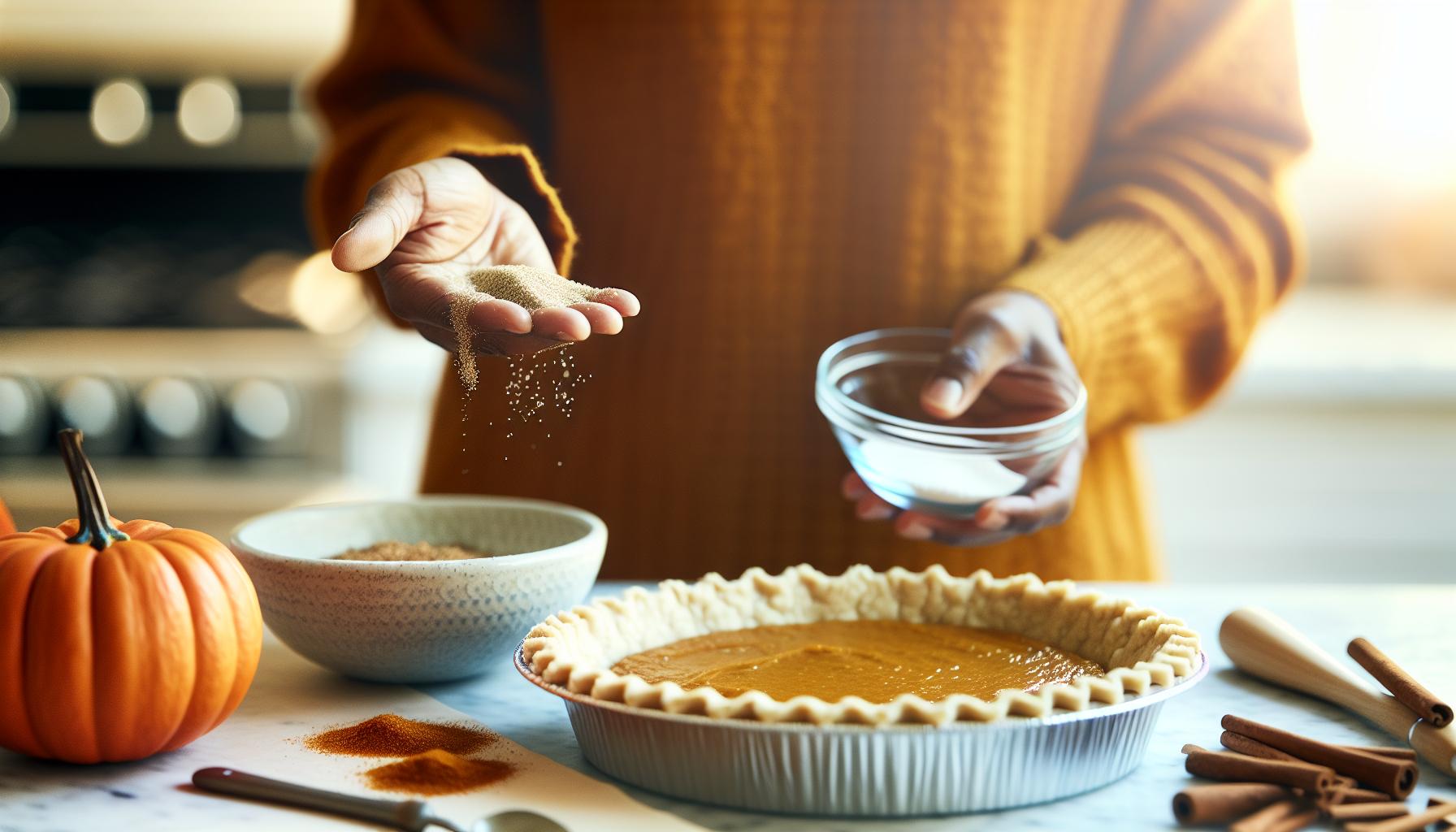As the holiday season approaches, the aroma of pumpkin pie often fills our homes, evoking nostalgic memories of family gatherings and celebrations. But for those living with diabetes, the question arises: can they indulge in this beloved dessert without compromising their health? Understanding how to enjoy traditional holiday treats while managing blood sugar levels is vital for many. This guide will help you navigate your way through the world of pumpkin pie, offering practical tips and alternatives that allow you to savor the flavors of the season. Together, let’s explore how you can create a delightful dessert experience that aligns with your health goals, ensuring that diabetes management doesn’t overshadow your holiday joy. Discover mindful eating strategies and creative substitutions that empower you to enjoy the sweetness of the season while staying in control of your health.
Can Diabetics Eat Pumpkin Pie? Understanding Blood Sugar Impact

Diabetic individuals often question whether they can enjoy classic holiday treats like pumpkin pie without negatively impacting their blood sugar levels. The answer isn’t a simple yes or no; it depends on several factors, including the ingredients, portion sizes, and overall meal planning. Pumpkin itself is a nutritious vegetable rich in fiber, vitamins, and minerals, which can help to moderate blood sugar levels. However, the traditional recipe’s heavy reliance on sugar, pie crusts made from refined flour, and even excessive spices can tip the balance, leading to spikes in glucose levels.
Understanding the glycemic index (GI) of foods is crucial for managing diabetes effectively. While pumpkin has a relatively low GI, when combined with high-sugar and high-carb elements, the overall impact can be detrimental. When considering pumpkin pie, it’s essential to focus on both the carbohydrate content and the total calories in each serving. Substituting high-sugar sweeteners with low-calorie or natural alternatives can greatly reduce the blood sugar impact without sacrificing flavor. Additionally, portion control plays a significant role; enjoying a small slice as part of a balanced meal may allow for an occasional treat without considerable consequences.
Incorporating pumpkin pie into a diabetes management plan successfully involves planning ahead. This means not just adjusting the recipe to be more diabetic-friendly but also ensuring that this sweet indulgence fits into the larger context of a well-balanced diet. Monitoring blood sugar levels after eating dessert can provide critical feedback, helping individuals understand how their body responds to different foods.
As you navigate holiday desserts, empowering yourself with knowledge and preparation can transform festive eating from a source of anxiety into an enjoyable experience. By making intentional choices and consulting with healthcare professionals, managing diabetes during the holidays becomes a less daunting task, allowing for celebration and enjoyment of traditional foods like pumpkin pie.
Nutritional Breakdown of Pumpkin Pie for Diabetics
When considering pumpkin pie as a dessert option, understanding its nutritional profile is paramount for individuals managing diabetes. Pumpkin pie, while delicious and often a holiday favorite, can vary significantly in its impact on blood sugar levels based on its ingredients and portion sizes. A standard slice of traditional pumpkin pie contains not only pumpkin puree – which is full of fiber, beta-carotene, and antioxidants – but also added sugars and refined carbohydrates that can elevate blood glucose levels.
For a typical 1/8 slice of pumpkin pie, the nutritional breakdown may look approximately like this:
| Nutrient | Amount per Slice |
|---|---|
| Calories | 320 |
| Total Carbohydrates | 45g |
| Dietary Fiber | 2g |
| Sugars | 20g |
| Protein | 3g |
| Fat | 14g |
The combination of carbohydrates and sugars in traditional pumpkin pie can lead to significant spikes in blood sugar levels. Individuals with diabetes are encouraged to focus on not just the carbohydrate content but also the overall caloric intake and nutritional value. The high sugar and refined flour content typically found in pie crusts can be particularly problematic. However, pumpkin as a base provides valuable nutrients that may help offset some of the negatives associated with dessert consumption.
One practical approach is to modify the traditional recipe by incorporating healthier ingredients. Using whole grain crusts, reducing the sugar content, or substituting with natural sweeteners like stevia or erythritol can significantly enhance the pie’s health profile. Moreover, adding nuts or seeds can contribute healthy fats, which may promote satiety and reduce the overall glycemic load of the meal.
Ultimately, enjoying pumpkin pie as part of a balanced meal – and in moderation – is key for individuals managing diabetes. Pairing a small slice with a protein-rich item, such as Greek yogurt, can help stabilize blood sugar levels. For those who need further personalization or specific dietary adjustments, consulting a healthcare provider or a registered dietitian can empower individuals in making informed decisions that align with their health goals. By being mindful of ingredients and portion sizes, pumpkin pie can still feature in the festive diet without compromising blood sugar control.
Alternatives to Traditional Pumpkin Pie Recipes

Pumpkin pie doesn’t have to be a guilty pleasure for those managing diabetes; there are plenty of alternatives that not only satisfy your sweet tooth but also align with dietary needs. Embracing creative twists on traditional recipes can make holiday gatherings enjoyable and inclusive for everyone, regardless of their dietary restrictions. Here are some innovative approaches to enjoy pumpkin pie without compromising blood sugar control.
One viable alternative is to create a crustless pumpkin pie. By skipping the crust altogether, you can significantly reduce the carbohydrate content. Simply blend pumpkin puree with eggs, unsweetened almond milk, and spices like cinnamon and nutmeg, then bake until set. This version not only saves on calories but also enhances the pumpkin flavor, making it a dense and hearty treat.
Another option is to use almond flour or coconut flour instead of traditional pie crust ingredients. Almond flour is lower in carbs and adds healthy fats, while coconut flour is rich in fiber. Combining these flour alternatives with natural sweeteners like erythritol or monk fruit can help keep blood sugar levels stable without sacrificing taste. You might also consider adding a layer of chopped nuts to the crust for added texture and nutritional benefits.
For those looking to further enhance their pumpkin pie game, consider integrating Greek yogurt into the filling. This addition can provide a creamy texture while also introducing protein, which helps mitigate blood sugar spikes. Mixing in spices such as ginger or allspice can bring an extra zing to the flavor, making it a unique offering at your holiday table.
Finally, experimenting with different sweeteners can lead to delightful results. Utilizing natural sweeteners like pure maple syrup (in moderation) or honey may still satisfy your craving while providing a better glycemic response. When choosing sweeteners, always consult with a healthcare professional or a registered dietitian to ensure it fits within your individualized meal plan.
These alternatives not only cater to dietary preferences but also create an opportunity for inclusion during festive meals. By exploring these creative options, you can craft a delicious pumpkin pie that celebrates the spirit of the season while maintaining mindful eating practices. Enjoying dessert doesn’t have to be a source of stress; with the right preparation and ingredients, it can be a delightful part of your holiday festivities.
How to Make Diabetic-Friendly Pumpkin Pie

Pumpkin pie is a beloved holiday dessert, but for those managing diabetes, finding a way to enjoy it without negatively impacting blood sugar levels can feel daunting. With a few strategic adjustments, you can create a diabetic-friendly version that captures all the flavor and festive spirit of this traditional treat. Whether you have family members with diabetes or are navigating personal dietary needs, making pumpkin pie a part of your holiday celebrations is definitely achievable.
To craft a healthier version of pumpkin pie, start by choosing a suitable crust. A delicious option is a crustless pumpkin pie, which reduces carbs significantly and allows the rich pumpkin flavor to shine through. Simply blend canned pumpkin, eggs, and unsweetened almond milk, along with spices like cinnamon and nutmeg, and pour the mixture into a greased pie dish. Bake at 350°F (about 175°C) until set. This not only saves on calories but also keeps it easy to make.
If you prefer a crust, opt for alternatives like almond flour or coconut flour instead of traditional wheat flour. These options are lower in carbohydrates and higher in fiber, helping to control blood sugar spikes. Combine your chosen flour with a natural sweetener such as erythritol or monk fruit, both of which help keep sugar levels stable. For added texture and nutrition, consider incorporating chopped nuts into the crust.
For the filling, enhance the pie by incorporating Greek yogurt, which contributes creaminess and protein-both beneficial for blood sugar management. Adding a bit of vanilla extract or additional spices like ginger may elevate the flavor further, creating a more memorable dessert. Remember to taste as you go to ensure the filling remains sweet enough while still being diabetes-friendly.
This approach enables enjoyment of pumpkin pie without guilt. It’s essential to remember that portion control plays a significant role in managing blood glucose levels. Stick to a modest slice and accompany it with a protein-rich food, like a handful of nuts or a dollop of Greek yogurt, which can help mitigate any glucose spikes. Always consult with a healthcare professional or registered dietitian when making significant changes to your diet or if you have questions about food choices specific to your health situation. By embracing these modifications, you can indulge in a warm slice of pumpkin pie and savor the holiday together without compromising your health goals.
Portion Control Tips for Holiday Desserts
Maintaining control during the holiday season can be a challenge, especially when it comes to desserts like pumpkin pie. Portion control is essential for managing blood sugar levels and still enjoying the festive flavors you love. One of the best strategies is to use smaller plates and utensils. Research shows that our brains can be tricked into feeling satisfied with less food if it looks like a full plate. By using a smaller dessert plate, you’ll naturally serve yourself a smaller portion, which can help prevent overindulgence.
Another effective tip is to pre-slice the dessert into smaller servings before the meal begins. This not only allows for easier portion control but also helps set expectations for how much you can enjoy without straying from a healthy eating plan. Enjoying pumpkin pie with a mix of other holiday dishes on your plate can also aid in portion management. By coupling a smaller slice of pie with a balanced plate full of vegetables, lean proteins, and whole grains, you can create a filling meal that stabilizes blood sugar levels.
To further enhance your dining experience while keeping portions in check, consider using toppings mindfully. Instead of heaping whipped cream or drenching the pie in sauces, use a light sprinkle of cinnamon or nutmeg to add flavor without extra calories or sugar. Think of toppings as flavor enhancers rather than necessities; a little goes a long way and can make your dessert enjoyable without overwhelming your blood sugar.
It’s also helpful to be mindful of your overall intake throughout the day. If you know dessert is coming, adjust your meals earlier in the day to include more fiber and protein. Foods high in fiber, such as fruits and vegetables, can aid in creating a feeling of fullness, making you less likely to overindulge in dessert. Being mindful, proactive, and focused on portion sizes allows you to enjoy the holiday spirit without sacrificing your health goals. Always keep in mind that consulting with a healthcare professional or dietitian can provide personalized advice tailored to your specific needs and help you navigate your dietary choices confidently.
Managing Blood Sugar Levels After Dessert Consumption
Consuming dessert, especially around the holidays, can often lead to feelings of guilt for those managing diabetes. However, understanding how to effectively manage blood sugar levels post-dessert can transform these moments into opportunities for enjoyment rather than stress. After indulging in a slice of pumpkin pie, it’s crucial to take proactive steps to ensure that your blood sugar levels remain stable.
One effective approach is to monitor your blood glucose levels. Checking your sugar levels about 1-2 hours after eating can provide valuable feedback on how your body reacted to the dessert. This strategy not only helps you gauge your response but also informs any adjustments you might need to make in the future. If you notice a significant spike, consider evaluating your portion size or the types of ingredients you’re using.
Incorporating physical activity following dessert is a powerful tool for managing blood sugar. A leisurely walk can help your body utilize that sugar for energy, minimizing the impact on your levels. Aim for at least 15-30 minutes of activity, whether it’s a post-meal stroll or engaging in light housework. Exercise promotes insulin sensitivity and can help balance blood glucose more efficiently.
Maintaining hydration is another key aspect. Water not only supports overall health, but it can also help dilute blood sugar levels after a sweet treat. Aim to drink a glass of water after enjoying dessert, and consider reducing calorie-rich beverages and opting for water or unsweetened drinks during meals.
Finally, consider how you plan your subsequent meals. If you indulge in dessert, aim to incorporate higher fiber and protein foods in your next meals to further stabilize your blood sugar. Foods rich in fiber can slow the absorption of sugar, resulting in steadier blood glucose levels. Balancing your diet throughout the day ensures that one dessert won’t derail your overall health goals, allowing you to partake in holiday traditions with confidence.
Navigating the festive season as a diabetic is not just about restriction-it’s about balance, mindfulness, and informed choices. Always consult with a healthcare professional or dietitian to tailor strategies that fit your personal health needs and ensure you’re making the best decisions for your well-being.
Understanding Carbohydrate Counting for Pumpkin Pie
Understanding the carbohydrate content of pumpkin pie is essential for anyone managing diabetes, especially during the holiday season when desserts abound. Carbohydrates play a pivotal role in blood sugar management, as they are broken down into glucose, impacting blood sugar levels. A typical slice of traditional pumpkin pie contains about 30-45 grams of carbohydrates, depending on the recipe and size of the slice. This is a significant amount when considering that many diabetics aim to limit their carbohydrate intake to maintain stable blood glucose levels.
When counting carbohydrates in pumpkin pie, it is helpful to break down the components contributing to the total carb count. Common ingredients in pumpkin pie include:
- Crust: The crust is often made from refined white flour, which can add a hefty dose of carbs.
- Filling: The filling typically includes pumpkin puree, sugar (or sweeteners), and eggs. The sugar is the primary carbohydrate contributor here.
- Additional Ingredients: Spices like cinnamon and nutmeg are low in carbs but add flavor without affecting blood sugar significantly.
To gauge how much of a dent pumpkin pie makes in your daily carbohydrate allowance, track not only the slice you consume but also how it fits into your meals throughout the day. Utilizing tools such as carbohydrate counters or mobile apps can simplify this process. Pairing a slice of pumpkin pie with a higher-protein or higher-fiber snack can also help mitigate the impact on blood sugar. For example, having a scoop of yogurt or a handful of nuts post-pie can slow down sugar absorption and stabilize your glucose levels.
Remember that calculating carbs isn’t the sole factor; it’s also crucial to consider your body’s unique response to different foods. Blood sugar monitoring is a powerful tool. By testing your glucose levels before and after enjoying a slice of pumpkin pie, you’ll understand how your body reacts and make adjustments in your future choices. Always consult with a healthcare professional or dietitian if you’re unsure about how to effectively manage carbohydrate intake, as personalized guidance is key to successful diabetes management.
Sweetener Options for Diabetic-Friendly Baking
Baking for diabetes doesn’t mean abandoning sweetness; rather, it opens the door to a world of healthier, flavorful alternatives. When it comes to pumpkin pie, choosing the right sweetener can make all the difference between indulging safely and jeopardizing blood sugar control. Many traditional recipes use granulated sugar, which can spike blood glucose levels, but fortunately, there are several diabetic-friendly options to consider.
One popular choice is stevia, a plant-based sweetener that is calorie-free and has no effect on blood sugar levels. Stevia can be much sweeter than sugar, so it’s important to use it in moderation. Another great alternative is erythritol, a sugar alcohol that has only about 6% of the calories of sugar but retains a similar sweetness. Unlike some other sugar alcohols, erythritol is less likely to cause digestive issues when consumed in reasonable amounts.
For those who prefer a more traditional flavor profile, monk fruit sweetener is another excellent candidate. This natural sweetener comes from monk fruit and is also calorie-free, making it perfect for baking. It often combines with erythritol to balance sweetness without adding carbs.
Choosing the Right Sweetener for Your Pumpkin Pie
When selecting a sweetener, it’s vital to consider not only taste but also how it interacts with other ingredients in your recipe. Here are a few tips to help you choose the most suitable sweetener for your pumpkin pie:
- Texture Matters: Some sweeteners, like erythritol or xylitol, can mimic the granulated sugar’s texture, making them ideal for pie crusts.
- Mixing Sweeteners: Don’t hesitate to combine different sweeteners to achieve the desired flavor and sweetness level. For example, a blend of stevia and erythritol can provide a balanced taste.
- Check the Labels: Always check labels for added ingredients that might impact blood sugar or include unwanted calories. Opt for pure, minimal-ingredient options whenever possible.
As you elevate your baking with these alternatives, remember that portion control remains a vital part of managing diabetes. A small slice of pumpkin pie made with diabetic-friendly sweeteners can be a delightful addition to your holiday table, so long as you stay mindful of serving sizes and overall carbohydrate intake. By making informed choices and experimenting with various sweeteners, you can enjoy festive flavors while maintaining your health. And as always, consult with your healthcare provider or dietitian for personalized advice tailored to your dietary needs.
Incorporating Pumpkin Pie into a Balanced Meal Plan
can be a delightful way for diabetics to enjoy the flavors of the season while still being mindful of their health. Pumpkin is not just delicious; it is also a powerhouse of nutrients, packed with fiber and vitamins, which can be beneficial for blood sugar management. The key is to approach pumpkin pie thoughtfully, ensuring it fits into your daily dietary goals without causing undue spikes in blood glucose levels.
To successfully include pumpkin pie in your meal plan, begin by considering the overall composition of your meals. Aim to balance carbohydrates with protein and healthy fats. For instance, if you plan to enjoy a slice of pumpkin pie for dessert, you might want to adjust your earlier meals to be lower in carbohydrates. Consuming a meal rich in vegetables, lean proteins like turkey or chicken, and healthy fats, such as avocado or olive oil, can help stabilize your blood sugar before dessert.
Here are some practical tips for including pumpkin pie in your meal plan:
- Mind Your Portions: Keep your slice of pumpkin pie small. A typical serving can often be reduced to about half of what is standard. This small indulgence will allow you to enjoy the flavor without overwhelming your body with excess sugar and carbohydrates.
- Add Nutrients: Consider enhancing your pumpkin pie with nutritious toppings. A dollop of Greek yogurt or a sprinkle of chopped nuts can add protein and healthy fats, helping to further balance the meal.
- Plan Ahead: If possible, test your blood sugar levels before and after consuming pumpkin pie. This will help you understand how your body reacts and allow you to make informed decisions for future indulgences.
Lastly, is not just about the dessert itself; it’s about the joy of celebrating with family and friends. The emotional aspects of enjoying holiday meals can contribute to well-being, so remember to savor the moment. Always consult with your healthcare team for individual dietary recommendations and adjustments tailored to your unique health needs. With a little planning and mindfulness, everyone can enjoy the festive flavors of the season, including pumpkin pie!
Celebrating Holidays with Diabetes: Tips and Strategies
The holiday season brings a blend of excitement and challenges for those managing diabetes, especially when navigating the delicious desserts that often accompany celebrations. Many may wonder if they can indulge in sweets like pumpkin pie without jeopardizing their health. The answer lies in mindful planning, informed choices, and embracing the joy of the season while maintaining control over blood sugar levels.
To enjoy the festive flavors without compromising health, it is essential to embrace a proactive approach to holiday meals. Consider creating a balance in your plate; fill it with nutrient-rich vegetables and lean proteins that can help stabilize blood sugar before dessert is served. Family gatherings offer a perfect opportunity to share the responsibility of health by inviting guests to bring dishes that align with diabetes-friendly guidelines. This way, everyone can enjoy a diverse buffet that points toward healthier options.
Another effective strategy is to establish healthy habits around portions and pacing. Enjoying a smaller slice of pumpkin pie alongside a balanced meal can satisfy cravings without overwhelming your system. Make it a point to savor each bite, allowing your senses to fully appreciate the flavors and textures, which can often lead to feeling satisfied even with less food. Moreover, engaging in light physical activity, such as a post-meal stroll, can help mitigate the impact of carbohydrates on blood sugar levels.
Lastly, it’s vital to remember that special occasions should primarily celebrate connections and traditions rather than focusing solely on the food. Share your challenges and successes in managing diabetes with family and friends; doing so can foster an understanding atmosphere that uplifts everyone. Keep in mind that every individual’s dietary needs and restrictions are unique, so always consult with your healthcare team for personalized recommendations. With mindful approaches, diabetic patients can enjoy pumpkin pie and other holiday treats while celebrating the season’s joy in a healthy, sustainable way.
Reading Labels: What to Watch for in Desserts
Reading dessert labels is crucial for those with diabetes, especially during the holiday season when indulgent treats abound. A single slice of pumpkin pie can vary significantly in its sugar and carbohydrate content, leading to potential spikes in blood glucose levels. Familiarizing yourself with effective label-reading strategies can empower you to make smarter choices that align with your health goals.
When inspecting dessert labels, pay particular attention to total carbohydrates and sugars. Start by checking the serving size, as many products will list nutritional information based on serving sizes that may not reflect how much you’re realistically consuming. Aim for desserts that offer lower total carbohydrates-ideally under 15 grams per serving-to help manage blood sugar levels more effectively. Moreover, be cautious of “hidden” sugars found in ingredients such as high-fructose corn syrup or cane sugar, which can significantly increase the overall sugar content.
Another vital component to examine is the fiber content. Higher fiber desserts can help slow the absorption of sugar into the bloodstream, making them a better choice for individuals with diabetes. Look for options that include whole ingredients or added fiber, which can not only improve digestion but also contribute to overall satiety. Lastly, consider ingredient quality; opt for desserts that use natural sweeteners, such as stevia or erythritol, instead of refined sugars, and choose those made with whole, unprocessed ingredients when possible.
To summarize, here are key points to remember when reading labels on desserts:
- Check total carbohydrates: Aim for lower amounts per serving.
- Identify sugars: Look for added sugars and be wary of high-fructose corn syrup.
- Favor fiber: Choose desserts with higher fiber content to help regulate blood sugar.
- Ingredient quality matters: Opt for natural sweeteners and whole ingredients.
Being vigilant about reading labels can significantly enhance your ability to enjoy desserts like pumpkin pie without compromising your health. Always consult with your healthcare team to create a personalized approach that fits your individual dietary needs. With this knowledge, you can savor the festive flavors while maintaining control over your diabetes management.
FAQ
Q: Can diabetics enjoy pumpkin pie during the holidays?
A: Yes, diabetics can enjoy pumpkin pie in moderation. It’s important to consider portion sizes and ingredients. Opt for diabetic-friendly recipes with lower sugar options, and monitor your blood sugar levels before and after consumption.
Q: What ingredients should diabetics avoid in pumpkin pie?
A: Diabetics should avoid traditional sweeteners like sugar and high-carb crusts. Instead, look for recipes that use alternative sweeteners such as stevia or erythritol and whole grain or nut-based crusts for better blood sugar management.
Q: How can I make traditional pumpkin pie healthier for diabetics?
A: To make a healthier pumpkin pie, use unsweetened pumpkin puree, substitute sugar with a low-calorie sweetener, and use a crust made from almond flour or oat flour. This reduces carbohydrates and overall sugar content while maintaining flavor.
Q: What are the best portion sizes for diabetics enjoying pumpkin pie?
A: A typical serving size for diabetics is about 1/8 of a pie. This portion offers a balance of enjoyment and manageable carbohydrate intake. Pair it with a source of protein, like Greek yogurt, to further stabilize blood sugar.
Q: Can I use regular pie crust for a diabetic-friendly pumpkin pie?
A: It’s better to avoid regular pie crusts as they are typically made from refined flour and can spike blood sugar levels. Instead, consider using a low-carb crust made from almond flour or a crustless version.
Q: How does pumpkin pie impact blood sugar levels for diabetics?
A: Pumpkin pie can impact blood sugar due to its carbohydrate content. Be mindful of the ingredients and portion sizes, as too much pie can lead to spikes in glucose levels. Always check your blood sugar after eating.
Q: What sweeteners are safe for diabetics to use in pumpkin pie?
A: Safe sweeteners include stevia, erythritol, or monk fruit. These alternatives provide sweetness without raising blood sugar levels significantly. Always check the labels for added sugars in pre-made sweeteners.
Q: What tips can help diabetics enjoy holiday desserts without excess sugar?
A: To enjoy holiday desserts, diabetics can practice portion control, focus on homemade recipes with healthier ingredients, and balance dessert intake with physical activity. Pair desserts with protein or fiber-rich foods to stabilize blood sugar levels.
Concluding Remarks
As you prepare for the holiday season, remember that enjoying pumpkin pie is possible with careful planning and mindful choices. Focus on recipes that are lower in sugar and high in fiber, which can make this festive dessert a delightful option for diabetics. To further enhance your holiday experience, consider exploring our guide on Healthy Holiday Alternatives and checking out tips for Balancing Treats with Diabetes.
Don’t hesitate to share your thoughts in the comments below or reach out for personalized advice from a qualified healthcare professional. If you found this guide useful, subscribe to our newsletter for the latest insights on diabetes management and delicious recipes tailored for you! Together, we can navigate the sweet side of life while keeping your health and well-being front and center. Happy holidays!












